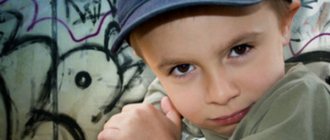Preface
This guide to psychotherapy is the result of work carried out at different times on the basis of the neurosis department of the Psychiatry Clinic of the Military Medical Academy, the crisis department of the Neurosis Clinic named after. Academician I.P. Pavlova, St. Petersburg City Psychotherapeutic Center, Clinic of Psychological Counseling and Psychotherapeutic Treatment.
Systemic behavioral psychotherapy is close to the psychotherapeutic direction, which is called “cognitive-behavioral psychotherapy.” However, the latter, in a methodological sense, is an artificial formation: two theoretically different scientific paradigms - behavioral and cognitive - were mechanically combined within the framework of one system of psychotherapeutic practices. Systemic behavioral psychotherapy, in contrast to cognitive-behavioral psychotherapy, is based on a single theoretical basis - the science of behavior, which is extremely accurately and completely outlined in the works of domestic scientists I.M. Sechenova, I.P. Pavlova, A.A. Ukhtomsky, L.S. Vygotsky, A.R. Luria, P.K. Anokhin and others. In this sense, the task of systemic behavioral psychotherapy was only to perceive the science of behavior as a holistic and consistent theoretical system, and then present the possibilities of psychotherapy as such (the system of its practices) within the framework of this holistic scientific paradigm.
For a more complete and accurate understanding of systemic behavioral psychotherapy, a psychotherapeutic model of psychopathology in “minor” psychiatry (general psychopathology of borderline psychiatry) within the framework of behavioral science is necessary. It is obvious that the effective use of psychotherapeutic tools without a clear understanding of the phenomenon of “disease” in the field of neurotic disorders seems extremely difficult. The absence of psychotherapeutic diagnoses, or - what would be perhaps even more correct - the lack of psychotherapeutic understanding of psychiatric diagnoses, significantly inhibits the development of a normal, effective and viable medical specialty, which, without a doubt, is psychotherapy. Research in this direction has already been carried out and is currently being prepared for publication as a separate book - “Psychotherapeutic Diagnostics”.
The authors hope that the Guide will become an interesting and, most importantly, a useful practical guide for psychotherapists and clinical psychologists.
Behavior is inherent only to living beings, and life is a plastic adaptation of internal changes to external changes, which is usually called the term adaptation.
There are three types of adaptation and maladjustment, related to each other: physiological, psychological and socio-psychological.
Physiological adaptation
— the property of the human body to expediently rearrange its functions in accordance with the requirements of the environment. An example that explains this phenomenon is the adaptation of the eye, say, after an hour of being in the dark, the light sensitivity of the eye can become 200,000 times greater than the original, and after the eye is illuminated, a person sees nothing for several seconds. This and any other physiological maladaptation manifests itself in more or less pronounced psychological maladjustment and deviant behavior.
Psychological adaptation .
Psychological adaptation can be clearly seen in the case of psychological maladjustment. An example of this is the phenomenon of tension, or stress - conditions that manifest themselves as deviant behavior and as a syndrome of physiological (vegetative and motor) and mental abnormalities caused by the novelty or complexity of the operating conditions. As I.P. Pavlov wrote, “The point here is not so much the strength of the influencing stimuli, but rather their novelty. This is also evident in our laboratory experiments; the main reaction of the passive defensive reflex is not to force, but to novelty. The irritation should be mild, but it should be new.
It should be noted that, firstly, the problem of tension and adaptation to the factors that cause it is essential for psychodiagnostics, and secondly, it has been studied in the conditions of flight training better than in other types of activities, and the data obtained can be used in any other conditions.
Socio-psychological adaptation
— ϶ᴛᴏ adaptation of the individual to communication with a new team. The ease and effectiveness, completeness of this type of adaptation depend on the characteristics of the team.
At the same time, as G.S. Vasiliev’s research has shown, to no less, and sometimes to a greater extent, they depend on the communicative abilities of the individual
as a set of personality properties, ensuring the effectiveness of his communication with other individuals and psychological compatibility in joint activities.
G. S. Vasiliev in the structure of communicative abilities identifies three main substructures and one of them is the main one for all three, the elements of which are collectivism, professionalism, the desire to communicate, goodwill, modesty, self-demandingness, experience in social activities, sthenicity of emotions, activity, self-control, intelligence, organization.
The first main substructure is the gnostic ability as a person’s ability to understand other people. Its elements are the desire to understand others, the ability to listen to a communication partner, and observation.
The second substructure is expressive ability as the ability to self-express one’s personality. Its elements are the desire to be understood by others, truthfulness, culture of speech, trust in partners.
The third substructure is interactional ability as the ability to adequately influence communication partners. Its elements are exactingness, politeness, tact, discipline, determination.
It should be noted that poor development of communication abilities, at least among some members of the team, as well as the presence of psychological incompatibility among them is a prerequisite for conflicts.
Conflict is a type of communication that manifests itself in the form of deviant behavior of its participants, which is based on various kinds of real or illusory, objective or subjective, and to varying degrees, conscious contradictions in the goals of communicating individuals when trying to resolve them against the background of emotional reactions and states.
The presence or absence of conflicts is the main factor determining the quality of the psychological climate of the team.
Speaking about personality traits that make adaptation
or determining
maladaptation
and thus leading to deviant behavior, it is extremely important to note that the development of domestic aviation and space psychology has determined attention to activity conditions called extreme, i.e., causing, due to their unusualness for a person, reactions of both the body and the individual that are at borders of pathological disorders.
By now, the influence of such extreme conditions as hypoxia, low and high air pressure, acceleration, weightlessness, high and low temperature, and sensory hunger has been well studied.
All these conditions of human activity are factors in various forms of his deviant behavior, which have a common one, determined by various degrees of clouding of consciousness, and a special one, determined by the specificity and degree of severity of each factor; individual, determined by the characteristics of the organism and personality of each individual.
Research on adaptation to extreme conditions has focused attention on the phenomenon of readaptation, as a secondary adaptation to the initial state.
For example, astronauts have an individually different period of adaptation to weightlessness and an equally, and sometimes more different, period of readaptation after returning to Earth. The readaptation of a diver after rising from depth is even more difficult, requiring gradualism, the violation of which is tragic. These are examples of physiological readaptation to extreme conditions
At the same time, readaptation must be both psychological and socio-psychological, and, moreover, purely individual. An example of the first is the different rates of inclusion in habitual activities, say, in the morning, after sleep, after vacation. An example of the second, sometimes called resocialization, is the inclusion in the work collective of a patient after his rehabilitation or who has been released after serving a prison term.
An example of the influence on the adaptation and re-adaptation of a person is hypnotraining under conditions of inspired weightlessness, carried out and described by L.P. Grimak.
It should be noted that the difficulty, slowness and incompleteness of adaptation
personality (and sometimes the organism) to changed, and even more so to extreme, conditions manifest themselves in a person in the form of maladapted deviant behavior.
And persistent adaptation to long-term extreme or even only to conditions of life and activity that are sharply different from normal conditions requires appropriate readaptation when returning to them.
In conditions of maladjusted behavior, psychosomatic interactions hidden in the norm are clearly manifested.
Theoretical section
Part one Systemic behavioral psychotherapy
The first part of the Guide is devoted to three main issues:
· firstly, it is necessary to give a detailed definition of systemic behavioral psychotherapy (SBP);
· secondly, to present a conceptual model of systemic behavioral psychotherapy (CM SBP);
· thirdly, consider the methodological problems of psychotherapeutic science.
Chapter One Definition of systemic behavioral psychotherapy
Systemic behavioral psychotherapy
is a system of practices that is based on the CM SPP and is implemented by the patient under the guidance of a psychotherapist, with the direct participation of the psychotherapist, as well as independently by the patient, to correct maladaptive behavior that leads to a subjective decrease in the quality of life of a person seeking psychotherapeutic help.
Let us expand on the concepts used in this definition.
Methods for preventing maladjustment
Currently, the problem of social maladjustment of minors continues to remain relevant in Russia. Neglect, homelessness, and crime among children and adolescents are dangerous both for themselves and for those around them. Street and neglected children have become an integral feature of everyday life in post-Soviet Russia. According to the government, their number in 2010 in the country was 1 million 130 thousand people, and according to estimates of the Federation Council and independent experts, about 3-4 million. In 2010, according to the Ministry of Education and Science of Russia, more than 300 thousand. children did not attend educational institutions. Accurate registration of such children in the Russian Federation is complicated by the fact that many parents do not always submit applications to the relevant authorities. The presence of a large number of maladjusted children - children deprived of a family, proper care, education, children with developmental disabilities, children leading an antisocial lifestyle, children who commit delinquency and crime - pose a threat to the future of the country.
In Russia, as throughout the world, children's problems are studied and solved by representatives of specific fields of knowledge: teachers, doctors, law enforcement officers, social service workers, etc. They all perform their professional functions. Their efforts, as well as the result, are aimed not at helping and supporting the child as a subject, but at solving the problems set before them by society. For example, teachers and lecturers are busy teaching children. However, they often do this without taking into account the characteristics of their health and psyche. This leads to increased fatigue of students, overload, nervous breakdowns, and deterioration of their health. And, therefore, this most directly affects the development of children, and subsequently the state of the entire society.
The position and development of children is determined by many factors. The most significant of them are: health, education, attitude towards the child in the family, material well-being and morality.
Thus, in order to prevent maladaptation of children and adolescents, it is necessary to radically change educational work with them in all those areas in which the formation of personality and socialization of children and adolescents is carried out: family, school, leisure, employment, health. And we need to start with the family, since this is where the main values and life orientation are laid.
The instability of socio-economic and political life, a combination of social, psychological, and psychosomatic factors significantly increase the number of maladjusted minors in Russia.
No rehabilitation will be effective if work is not carried out with the child’s family. Parents are taught how to properly interact with children through learning about the characteristics of children growing up, learning how to communicate correctly, and resolving conflicts. The main goal of preventive activities in social work is to identify the causes and conditions that lead to deviations in the behavior of children and adolescents, to prevent and reduce the likelihood of deviations using socio-economic, organizational, educational, legal, pedagogical and psychological measures. In preventive work, the ability to correctly and flexibly navigate each specific situation, to objectively, with scientific reliability, generalize the factual material, having carefully studied all the reasons for the identified deviations and the conditions in which they became possible, is of utmost importance.
In 1999, the Federal Law “On the Fundamentals of the System for the Prevention of Neglect and Juvenile Delinquency” No. 120-FZ came into force. This has created additional opportunities for strengthening the social protective principle of preventing child neglect, further developing a network of social protective institutions, and intensifying a comprehensive solution to the problems of children in difficult life situations based on closer interaction of all entities included in the system for preventing neglect.
Today we have a situation where the number of families with maladjusted children is increasing exponentially. What to do? What measures should be taken to stop this process?
There are ways out of this situation, but the families themselves are not able to correctly assess their situation and help themselves. The expression “saving drowning people is in the hands of the drowning people themselves” is unacceptable in this situation, so we need specialists who are ready to take control of these families, their children and work comprehensively with them in certain areas. Today the problem of “families at risk” and, as a consequence, maladaptation children and adolescents is of current importance. It is necessary to create a system covering the family, educational institutions, administrative bodies, state and non-state centers for working with children and adolescents, focused on caring for children, their upbringing, preventing and overcoming the maladjustment of minors. An integrated approach is needed to solve this problem, which today can be called a state problem. The practice of providing social assistance and support to children abroad and in Russia shows that today there is an acute problem of creating and searching for new types of institutions and changing the content of work in them with children who find themselves in difficult life situations and in need of this help. Today it can be stated that the provision of social protection for children and adolescents in Russia is gradually emerging from the crisis to a new professional level. In many regions, an extensive system of social services is being created and operates, employing a large, qualified staff of social workers, teachers and psychologists.
In many social rehabilitation centers for minors, a situation has arisen where local social service specialists are forced to persuade parents to bring their child to the Center, and they are not always successful. This means that today social services have not yet fully demonstrated themselves, that they have not earned authority among the population, and many families are ready to live from hand to mouth, refusing the help of a government agency, which leads to maladaptation of the minor.
But, nevertheless, the need for social rehabilitation centers for minors does not decrease; their role in the life of children and the protection of their legal rights and interests increases.
Currently, there is no body at the federal level that would deal with the problems of children and childhood. The question of creating a federal body whose responsibilities would include the development and implementation of a state strategy in the interests of children, to insist that the financing of childhood is considered one of the most important national government tasks.
Disadaptation
Disadaptation
a mental state that arises as a result of a discrepancy between the sociopsychological or psychophysiological status of a child and the requirements of the new social situations. S.A. Belicheva, depending on the nature, character and degree of violations of social adaptation, distinguishes: 1) pathogenic maladaptation that occurs with deviations in mental development and neuropsychiatric diseases, which are based on functional-organic lesions of the central nervous system; 2) psychosocial maladaptation associated with the gender, age and individual psychological characteristics of the student (crisis phenomena, character accentuations, features of the emotional-volitional, cognitive and motivational spheres). These features make him a certain non-standard, difficult to educate, requiring an individual pedagogical approach and, in some cases, special psychological and pedagogical correctional programs that can be implemented in a family, educational institution and other social institutions; 3) social disadaptation, expressed in violation of moral and legal norms, in asocial forms of behavior and deformation of the internal regulation system, referent and value orientations, and social attitudes. When the socialization process is disrupted, a phenomenon such as a student’s educational maladaptation is observed, which is expressed in his persistent educational failure, severance of ties with the educational institution, leading to the individual’s lack of formation of cognitive motives, interests and educational skills.
Rate the definition: Excellent definition – Incomplete definition ↓
Source: Pedagogical encyclopedia “Education of a healthy lifestyle for students”











